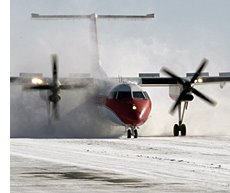
Which Airline to FlyDuring a Snow Storm
American, United Are QuickTo Cancel, While Continental,JetBlue Stay Aloft LongerFebruary 21, 2006; Page D1Neil Gallagher wanted to get home to New York from San Juan, but a potent snowstorm was roaring up the East Coast on Saturday, Feb. 11. American Airlines canceled his flight and gave him a blanket for bunking down in the terminal. Then he noticed a JetBlue Airways flight leave for New York.
The next day, American again canceled flights, and JetBlue continued to fly. Mr. Gallagher, an engineering professor at a Long Island college, bought a $215 ticket and finally landed at Kennedy International Airport about 1 a.m. on Monday, Feb. 13.
"It seemed to me that American and JetBlue had quite different philosophies about how to handle it," Mr. Gallagher said.
They do. When storms disrupt travel, some airlines are more aggressive than others. Just as some travelers prefer to wait out storms in comfort and certainty while others fight to get there as quickly as possible, airlines make the same choices and fly different courses in storm situations. But even when airlines continue to fly during bad weather, it doesn't mean customers get to their destinations on time: flights can face long delays or can end up rerouted to far-away airports.
An analysis of airline cancellations at East Coast airports during the severe snow storm 10 days ago shows the airlines' differing attitudes in action, and offers travelers a chance to make better decisions about which airline they'd prefer when storms threaten travel.
AMR Corp.'s American and UAL Corp.'s United Airlines, for example, prefer to batten down early to keep planes and crews out of the storm's path and minimize both customer inconvenience and financial loss. "We would rather cancel early rather than wait and have passengers trapped at the airport," said American spokesman John Hotard.
The risk: Losing or angering customers who could have made it home if storms aren't as bad as predicted, or show up later than forecast.
JetBlue and Continental Airlines, in contrast, try to fly as much as they safely can as long as they can, figuring that's best for customers and their bottom line. But if they guess wrong about the weather, they risk having planes divert to other airports and end up stuck for hours or even days.
On Saturday, Feb. 11, as the storm hit Washington and moved toward New York, United canceled 39% of its scheduled flights into and out of the three main New York airports (La Guardia, Kennedy and Newark, N.J.). American canceled 28% of its New York schedule, according to flight records compiled by FlightStats, the aviation data unit of Conducive Technology Corp.
Continental, however, flew 90% of its schedule and JetBlue flew 97% of its New York flights, according to FlightStats data. "We believe customers want to get where they're going even if it's very late, so we fly as much as we can," said JetBlue spokesman Bryan Baldwin.
On Sunday, Feb. 12, American flew only 13 flights into or out of New York; United just four, according to FlightStats. JetBlue had 60 arrivals and departures; Continental 52. And on Monday, JetBlue and Continental both operated more than 80% of their schedule -- better than American and United.
United says it found in years past it operated too many flights in winter storm situations, and disruptions meant it took several days to recover back to normal operations. The result of earlier cancellations in the latest storm was "we got back to normal much more quickly," said Stephen Forte, senior vice president of flight operations.
But Continental says forecasts overstate storms more often than understate, and so it prefers to wait as long as possible before slashing schedules.
"Sometimes the easiest thing to do is cancel early, but that's not the best thing for the customer," said Mark Moran, executive vice president for operations at Continental.
On Sunday, not all the flights launched by JetBlue and Continental during the storm made it as scheduled. Nine JetBlue flights diverted to airports like Rochester, Syracuse and Buffalo in New York before making it to JFK late Sunday. About 20 Continental flights inbound from Europe had to divert to Montreal, Cleveland, Syracuse and Gander, Newfoundland.
Both airlines said they thought JFK would open to landings by noon Sunday, so they launched some early morning flights headed to New York. But the snow kept coming. One JetBlue flight from the Dominican Republic diverted to Washington, where, while sitting on a taxiway awaiting takeoff clearance, the airline delivered 30 pizzas to tired, hungry passengers.
Diversions are costly to airlines and inconvenient for customers. If crews run out of allowable duty time -- a pilot's work day is limited by federal rules -- then a plane, its passengers and crew may be stranded even if the weather improves. An idle airplane means many other flights may have to be canceled.
Problems sometimes compound. One Continental plane in Gander had a mechanical problem with a door, and a replacement jet had to be flown in the next day to get customers to Newark.
All airlines say they always operate within set safety parameters -- if conditions are too poor, they don't fly, or pilots divert to an airport with better weather conditions. But the recent crash of a Southwest Airlines jet in Chicago, running off a runway in a snow storm, show there can be perils in being too aggressive at flying in bad weather. Icy runways, poor visibility and unfavorable winds can leave little margin for mistakes or malfunctions.
Beyond the vagaries of weather forecasting, many factors complicate how airlines operate in storm situations. Holiday weekends can prompt airlines to be more aggressive since there are few empty seats for passenger rebooking. Running a hub in the path of a storm, as Continental and JetBlue do in New York, doesn't allow as much latitude to pull back since planes and customers are clustered at the hub.
And there's often a question of whether employees will make it to work -- both for the airline and for crucial airport functions like Transportation Security Administration screening.
The airport itself influences what airlines can do. Newark and Kennedy airports recovered more quickly on Monday than La Guardia, where space is extremely tight, airline officials said. That gave Continental and JetBlue an advantage over American, United and Delta, which fly more from La Guardia. Plows at La Guardia, for example, pushed snow piles into five of American's 11 gates, crimping flights on Monday. A spokeswoman for the Port Authority of New York and New Jersey, which operates the New York City area airports, said La Guardia typically has more cancellations and delays than Kennedy and Newark.
But some of the differences come from divergent strategies. While some airlines pulled planes out of New York on Saturday so they'd be available for trips in other parts of the country all weekend, US Airways left planes at La Guardia Airport.
Having a plane snowbound for 36 hours is expensive since it's not earning money while grounded. But on Monday, US Airways caught up by operating 92% of its New York flights, higher than any other major airline. Others had to wait for flights to arrive Monday morning before any departures could go out; US Airways picked up passengers from competitors.
"We already had planes on the ground, which helped us get off to a good start early Monday morning," said Philip Gee, a US Airways spokesman.




No comments:
Post a Comment